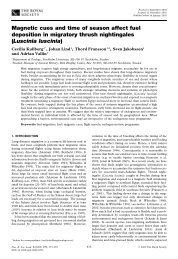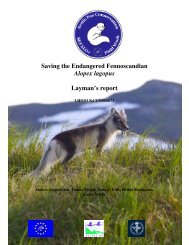788 NIKLAS JANZ ET AL.we have been conservative in our acceptance of a host plantinto the repertoire of a butterfly. Atypic<strong>al</strong> records have onlybeen included if they where independently corroborated byat least two sources.We <strong>al</strong>so conducted a series of larv<strong>al</strong> rearing experimentsin which we tested the ability of larvae of different speciesto feed and survive on a number of plants (cf., Scriber 1988;Futuyma <strong>et</strong> <strong>al</strong>. 1993, 1994). The plants were selected so thatthey represented as large part as possible of the combinedhost range of the Nymph<strong>al</strong>ini. In addition, we tested a numberof plants outside the norm<strong>al</strong> repertoire of the clade to controlfor the possibility that the larv<strong>al</strong> capacities to feed on nonhostswere randomly distributed over the plant phylogeny(Appendix 1). Not <strong>al</strong>l butterfly species were tested on <strong>al</strong>lplants, due to lack of butterfly and plant materi<strong>al</strong>; our firstpriority was to try rearing larvae from <strong>al</strong>l butterfly specieson select representatives of the most commonly used hostplantgroups: Urticaceae, Ulmaceae, Cannabidaceae, S<strong>al</strong>icaceae,Ericaceae, Grossulariaceae, Rosaceae, B<strong>et</strong>ulaceae,and Asteraceae. Of these families, Asteraceae was consideredleast cruci<strong>al</strong> (because it is only used by the genus Cynthia,outside the foc<strong>al</strong> group of the study), so when necessary thisfamily was omitted in the establishment tests. Consequently,the reconstruction of potenti<strong>al</strong> host-plant use is less reliablefor Asteraceae than for the rest of the plant families mentionedabove. Successful establishment and growth of larvaewere coded from 0 to 6, where 0 means no success at <strong>al</strong>l and6 means surviv<strong>al</strong> to pupation. In-b<strong>et</strong>ween these endpointslarvae were given a code (1–5) depending on the larv<strong>al</strong> stag<strong>et</strong>hey managed to reach on the plant in question. Successfullyreaching the second instar (code 2) was used as an indicationof larv<strong>al</strong> feeding capacity in the optimizations. Reaching thesecond instar means that they have to compl<strong>et</strong>e a full molton the plant, which we take as an indication of some abilityto feed on the plant, an ability that may conceivably be moredeveloped in other gen<strong>et</strong>ic variants of the species. Reachingthe second instar typic<strong>al</strong>ly meant surviving on the plant for5–7 days, and molt in these butterflies is not possible withoutprior feeding and growth.Typic<strong>al</strong>ly, five larvae of each species were tested on eachplant. This is a much too sm<strong>al</strong>l number to achieve any reliablescreening of feeding capacity, but it was a necessary compromise,<strong>al</strong>lowing us to test the larvae on more plant species.In addition, in most cases only one representative of eachplant family was tested. Accordingly, failures to feed andsurvive on a plant do not necessarily mean that the specieshas no capacity to feed on the plant family in question. Anypositive result, however, is a reliable indication that such acapacity does exist in the species. In some rare cases, theestablishment failed on a plant from a family that a butterflyspecies is known to use as a host (perhaps because the Swedishplant species used was not the species present in thebutterfly’s native area). This further illustrates that a scoreof 0 in the establishment test cannot be taken as evidenceagainst a capacity to feed on the plant family in question.For this reason, establishment data are only used to add tothe actu<strong>al</strong> host use in the expanded datas<strong>et</strong>, not to del<strong>et</strong>e anassociation.To test wh<strong>et</strong>her the successful establishments were biasedtoward plants that are used by other members of the Nymph<strong>al</strong>initribe, we an<strong>al</strong>yzed the establishment data withFisher’s exact test on a 2 2 contingency table (success/failure host/nonhost). Again, reaching the second larv<strong>al</strong>instar was classified as a successful establishment.Tracing Host-Plant RangeWe first used the literature data to trace actu<strong>al</strong> host plantuse on the butterfly phylogeny as binary characters usingparsimony. To assess wh<strong>et</strong>her there is a phylogen<strong>et</strong>ic sign<strong>al</strong>in the host-plant data on this level of resolution, we comparedthe consistency index (CI) of the actu<strong>al</strong> host-plant data onthe given phylogeny with 100 optimizations where the actu<strong>al</strong>character states had been randomly reshuffled among butterflytaxa.The results of the optimization of actu<strong>al</strong> host-plant usewere compared with optimizations of the same data extendedwith the results from the larv<strong>al</strong> establishment tests (ide<strong>al</strong>ly,potenti<strong>al</strong> host-plant use). It is hardly likely that loss of a hostplantassociation requires as much evolutionary modificationas colonization of a new plant. Under some circumstances,host-plant losses require no gen<strong>et</strong>ic modification at <strong>al</strong>l, butcan be entirely attributable to extern<strong>al</strong> factors, such as changesin plant and insect distribution patterns. Consequently,weighting gains and losses equ<strong>al</strong>ly may not give a fair reconstructionof the patterns of host-plant use. We thereforeperformed an addition<strong>al</strong> s<strong>et</strong> of optimizations of the same hostplantdata, where gains were given twice the transformationweight than losses. Admittedly, transformation weights thatcorrespond to the actu<strong>al</strong> costs of gains and losses are difficultto obtain, and our scheme was chosen rather arbitrarily. It isonly intended to serve as an illustration of the impact thatthe transformation-weighting scheme has on the optimizations.See Wahlberg <strong>2001</strong> for a more thorough discussion ofthis issue.In addition, we tested the hypothesis of speci<strong>al</strong>ization asa dead end. If there is such a univers<strong>al</strong> direction<strong>al</strong>ity in hostrange evolution toward increasing speci<strong>al</strong>ization, polyphagyshould be ancestr<strong>al</strong>, whereas speci<strong>al</strong>ization should show amore apic<strong>al</strong> distribution in the phylogen<strong>et</strong>ic tree. Kelley andFarrell (1998) used a modified version of the PTP test (Faithand Cranston 1991) to demonstrate that monophagy had anapic<strong>al</strong> distribution in Dendroctonus bark be<strong>et</strong>les. Unfortunately,this m<strong>et</strong>hod would require us to force host range variationinto a dichotomous character, which would discardmuch of the dynamics in our datas<strong>et</strong>. A simple but direct<strong>al</strong>ternative way to test for direction<strong>al</strong>ity in the process of hostrange evolution is to compare the tot<strong>al</strong> number of host-plantgains (colonization) and losses (typic<strong>al</strong>ly corresponding tospeci<strong>al</strong>ization) in the phylogeny. If there is a trend towardincreasing speci<strong>al</strong>ization, there should be more host-plantlosses than gains. However, gains need not necessarily leadto host range expansion if the origin<strong>al</strong> host is immediatelylost from the repertoire (i.e., on the same branch in the phylogeny).If host range is not to be extended, the number ofcolonizations directly followed by exclusions (host shifts)should outnumber the number of colonizations without exclusions(widening of the host-plant range). In this an<strong>al</strong>ysis,we used optimizations of both the origin<strong>al</strong> data matrix with
EVOLUTIONARY DYNAMICS OF SPECIALIZATION789TABLE 2. Summarized results of the larv<strong>al</strong> establishment tests (see Appendix 1 for d<strong>et</strong>ails). Establishments were coded from 0 to 6, where0 means no establishment and 6 surviv<strong>al</strong> to pupation. The codes 1–5 correspond to the larv<strong>al</strong> stage the larvae succeeded to reach. Combinationsof butterflies and plants that were not tested are marked with a dash. Successful establishments (to any degree) are marked with bold,establishments on plants that are not actu<strong>al</strong>ly used as hosts are marked with underlined bold. Table entries marked with an asterisk indicateestablishment failures on plant families that the butterfly species is known to use in the field. Nymph<strong>al</strong>is antiopa was sampled from Stockholm,Sweden (marked ‘‘Swe’’) as well as from Mount Rainer, Washington State (marked ‘‘USA’’).Araschnia levanaBassaris iteaCynthia carduiVanessa at<strong>al</strong>antaVanessa indicaAglais milbertiAglais urticaeInachis ioNymph<strong>al</strong>is antiopa (Swe)Nymph<strong>al</strong>is antiopa (USA)Nymph<strong>al</strong>is polychlorosNymph<strong>al</strong>is xanthomelasKaniska canacePolygonia c-<strong>al</strong>bumPolygonia c-aureumPolygonia egeaPolygonia faunusPolygonia gracilisPolygonia interrogationisPolygonia satyrusUrticaceae Ulmaceae Cannabidaceae S<strong>al</strong>icaceae B<strong>et</strong>ulaceae Grossulariaceae Ericaceae Rosaceae Asteraceae66666666454106666066001010006161060000600000004600—10660000*600006000666606001000000000006500060010000000000010100600660000000000—050060060*000—20000030600000—0000—60—00000———0—0—000only literature data, and the extended matrix that includedlarv<strong>al</strong> feeding capacities from our establishment tests.RESULTSHost-Plant Data and Larv<strong>al</strong> Establishment TestsAlthough the tribe Nymph<strong>al</strong>ini is associated with mor<strong>et</strong>han a dozen plant families, the dominating theme is definitivelyUrtic<strong>al</strong>es, especi<strong>al</strong>ly Urticaceae (Table 1, Fig. 2). Thisis <strong>al</strong>so by far the most likely ancestr<strong>al</strong> host-plant associationfor this group. The other plants have gradu<strong>al</strong>ly been addedto the repertoire by a number of host range expansions, mostnotably in the closely related genera Nymph<strong>al</strong>is and Polygonia(and the immediate ancestor to these genera) and in the verypolyphagous genus Cynthia (Fig. 2). Results from the larv<strong>al</strong>establishment tests are summarized in Table 2 (and are shownin d<strong>et</strong>ail in Appendix 1). There were 15 successful establishmentsof plants that are not used as hosts by the speciesin question. Among these, there was a significant bias towardplants that are used as hosts elsewhere in the Nymph<strong>al</strong>ini(Fisher’s exact test, P 0.045). In fact, only the extremelypolyphagous Cynthia cardui was able to initiate growth onany of the plants outside the norm<strong>al</strong> repertoire of the tribe(it successfully reached pupation on Ranunculus acris in Ranunculaceae).There were other patterns in what plant speciesthat did support larv<strong>al</strong> growth. The most noticeable resultwas that <strong>al</strong>l butterflies tested managed to feed successfullyon Urtica dioica (Urticaceae), with the exceptions of Kaniskacanace and Polygonia gracilis (Table 2). The latter has apparentlyfulfilled a compl<strong>et</strong>e switch from the dominating Urticacea<strong>et</strong>heme to Ribes (Grossulariaceae), whereas K. canacerepresents the most dramatic shift in host-plant use in thisclade, now feeding exclusively on monocotyledons (Smilacaceae).However, as mentioned before, establishment failuresshould be treated with caution in this an<strong>al</strong>ysis becaus<strong>et</strong>he sample of larvae was very sm<strong>al</strong>l. The two other familiesin Urtic<strong>al</strong>es, Ulmaceae and Cannabidaceae, <strong>al</strong>so turned outto be accepted for feeding by a wider range of butterfliesthan actu<strong>al</strong>ly use them as hosts (Table 2). The results of theestablishment tests <strong>al</strong>ign well with previous findings by Futuyma<strong>et</strong> <strong>al</strong>. (1995) that colonizations are constrained by gen<strong>et</strong>icvariation in host use.Another interesting result is that Polygonia c-<strong>al</strong>bum wasable to survive until eclosion on Vaccinium myrtillus (Ericaceae).Ericaceae is a plant family that is used by most ofits close relatives (however, the actu<strong>al</strong> host genus is Rhododendron),but is not believed to be used as a host plant byP. c-<strong>al</strong>bum. Some results were unexpected, such as the abilityof Vanessa indica to feed on S<strong>al</strong>ix (S<strong>al</strong>icaceae) and the abilityof N. polychloros to feed on Vaccinium (Ericaceae) and Ribes(Grossulariaceae).Tracing Host-Plant RangeOptimizing actu<strong>al</strong> host-plant use onto the butterfly phylogenyas binary characters suggests sever<strong>al</strong> independent colonizationsof most major host-plant families used in Nymph<strong>al</strong>ini(Table 3), som<strong>et</strong>imes reaching numbers as high asfive to nine colonizations, as with Ulmaceae. The 12 plantfamilies have been independently colonized 29 to 37 timesin this tribe, according to the unordered optimization of actu<strong>al</strong>host-plant data. Nevertheless, there is still a clear phylogen<strong>et</strong>icsign<strong>al</strong> in host-plant data within Nymph<strong>al</strong>ini. The optimizationof actu<strong>al</strong> host use data produced a higher consistencyindex than optimizations resulting from randomly reshuffledhost-plant data, this is, the butterfly phylogeny is agood predictor of host-plant use (Fig. 3). Still, consideringthe conservatism of host-plant use on higher taxonomic lev-
















